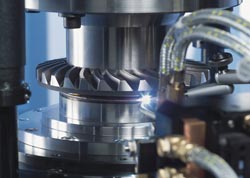Every kilo shedded counts – laser welding puts the automotive industry "on a diet"

<br>
The level of innovation behind these efforts is exemplified by passenger car transmissions, whose gear wheels and related components are manufactured by the millions and require optimized designs. To ensure that manufacturing processes run smoothly and efficiently, engineering specialist EMAG, employs high-tech solutions such as laser welding to realize spectacular results.
The differential transmission is a key component in vehicles and is manufactured millions of times over. Already perfected, is it possible to make the design even lighter? Engineers believe so and have created a simple, yet highly effective weld joint that is used by German auto makers to replace the previous threaded connection between differential components. This reduces the amount of material required, which in turn lowers the unit price of such a high-volume assembly. The weight of the differential housing is also reduced by approximately 1.2 kilograms. “This reduction is nothing short of impressive in the automotive world,” explains Dr. Andreas Mootz, Managing Director of EMAG Automation.
Process integration ensures efficient production
But how is the welding work carried out? After all, enormous production quantities are involved. Automated ELC equipment from EMAG is used to manufacture the transmissions. The machine starts by loading components, then presses them together and welds the gap. Additional processes may also be carried out depending on the component handled. Each gear wheel is finished in just twelve seconds, and all differential components are fully welded in no more than 40 seconds. “Laser welding is key here and integrates technology that controls the laser beam with exacting precision,” explains Mootz.
A world leader in transmission components
The welding specialists at EMAG enjoy a long history of success. Today, all renowned auto makers use laser welding in their manufacturing processes. German engineering companies also benefit from the recent market trend, which has resulted in an increased demand for gear wheels thanks in part to the dual-clutch transmission. This trend extends to conventional manual gearboxes as well, many of which integrate more gear ratios than before to further lower fuel consumption.
Contact person
Mr. Oliver Hagenlocher
Press and publishers
Tel: +49 / 7162 / 17-267
Fax: +49 / 7162 / 17-199
ohagenlocher@emag.com
Media Contact
More Information:
http://www.emag.comAll latest news from the category: Machine Engineering
Machine engineering is one of Germany’s key industries. The importance of this segment has led to the creation of new university degree programs in fields such as production and logistics, process engineering, vehicle/automotive engineering, production engineering and aerospace engineering among others.
innovations-report offers informative reports and articles covering technologies such as automation, motion, power train, energy, conveyor, plastics, lightweight construction, logistics/warehousing, measurement systems, machine tools and control engineering.
Newest articles

Silicon Carbide Innovation Alliance to drive industrial-scale semiconductor work
Known for its ability to withstand extreme environments and high voltages, silicon carbide (SiC) is a semiconducting material made up of silicon and carbon atoms arranged into crystals that is…

New SPECT/CT technique shows impressive biomarker identification
…offers increased access for prostate cancer patients. A novel SPECT/CT acquisition method can accurately detect radiopharmaceutical biodistribution in a convenient manner for prostate cancer patients, opening the door for more…

How 3D printers can give robots a soft touch
Soft skin coverings and touch sensors have emerged as a promising feature for robots that are both safer and more intuitive for human interaction, but they are expensive and difficult…





















